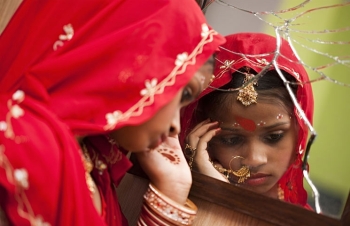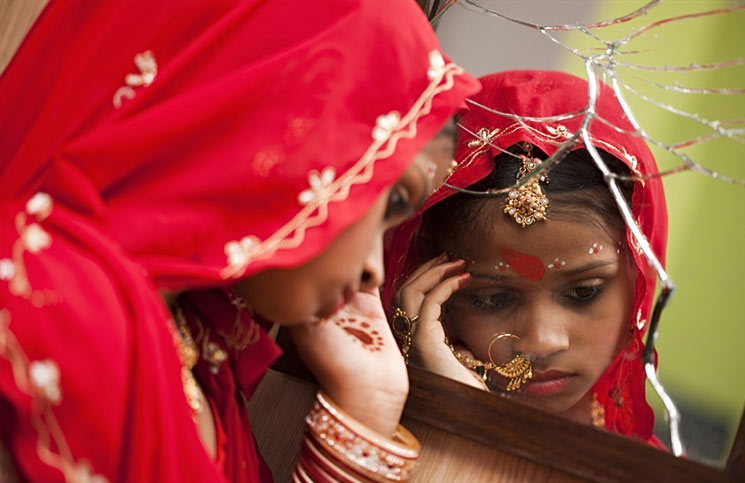
.png) Aarti
Aarti

The arrest of over 2700 persons on charges of allegedly marrying minor girls or facilitating/solemnizing child marriages in Assam has generated mixed reactions.
Reportedly, the crackdown started following a decision taken by the State Cabinet to reduce infant mortality and maternal mortality rates as also prevent child marriages. So, those who marry girls aged below 14 are liable to face action under the Protection of Children from Sexual Offences (POCSO) Act, 2012. Likewise, those who marry girls in the age group of 14-18 years will be tried under the Prohibition of Child Marriage Act, 2006.
Child marriages are prevalent for a variety of reasons. Worldwide, 650 million girls and women alive today were married in childhood and child marriage is most common in sub-Saharan Africa and South Asia, where 34 percent and 28 percent of young women aged 20–24 years were married in childhood. 12 million child marriages are said to take place each year, largely in Northwest Central Africa, South Asia and South America. 76 percent of girls in Niger, 59 percent in Bangladesh and 36 percent in Brazil are married before they attain 18 years. The US accounted for 300,000 child marriages during 2000-18, where such underage marriages is legal in 44 states. 813 child marriages were reported in Germany in 2017-20, where it is illegal. In India, according to official statistics, 2530 cases of child marriages were registered during the period 2016 to 2020. The cause for concern is that worldwide one in five girls are married before the age of 18 years and India accounts for a third of child brides globally with 16 percent of adolescent girls aged 15–19 currently married.
During the British Raj, the minimum legal age for marriage in India was fixed at 14 years for girls and 18 years for boys under the Child Marriage Restraint Act, 1929. In 1978, this Act was amended, raising the age to 18 years for girls and 21 years for boys. The Prohibition of Child Marriage Act, 2006 replaced the 1929 Act with the same minimum age limits. The purpose and rationale behind the Prohibition of Child Marriage Act, 2006 is that there should not be a marriage of a child at a tender age as he/she is neither psychologically nor physically fit to get married. There could be various psychological and other implications of such marriage, particularly if the child happens to be a girl.
In actuality, child marriage is a violation of human rights, compromising the development of girls and often resulting in early pregnancy and social isolation, with little education and poor vocational training reinforcing the gendered nature of poverty. In 2021, the Prohibition of Child Marriage (Amendment) Bill was introduced in the Parliament which seeks to increase the minimum age of marriage for females from 18 to 21 years (at par with males). The Bill has since been referred to the Parliamentary Standing Committee on Education, Women, Children, Youth and Sports for examination.
Although child marriages are decreasing globally because of laws that have raised the marriage age to 18 years, the cause for concern is that in some developing countries where it is rampant, it has serious ramifications for health and wellbeing of young mothers. In a nutshell, getting the girls married at an early age, when they are not physically mature, leads to high rates of maternal and child mortality. As child marriage is also associated with pregnancy at a young age, the young mothers are often more susceptible to various health risks associated with early sexual initiation and childbearing, including HIV and obstetric fistula. Early marriage almost always deprives girls of their education or meaningful work, which contributes to persistent poverty. There have been instances where many young girls who lack status, power and maturity are often subjected to domestic violence, sexual abuse and even social isolation. Thus, child marriage perpetuates an unrelenting cycle of gender inequality, social isolation, sickness and poverty.
Last September, a 40-year-old man was arrested in Jaipur for allegedly buying a minor girl for Rs 3 lakh, repeatedly sexually assaulting and harassing/torturing the child for not conceiving. The girl who hailed from a remote Rajasthan village had moved with her mother to stay in her live-in partner’s house, but the latter sold the hapless minor to a man who “married her”. Over the next nine months, her “husband” repeatedly raped and abused her if she resisted. It was only after the man and his family also started shaming her because she hadn’t conceived, she managed to escape, after several attempts, and reach Jaipur where she was spotted by child rights activists and handed over to the police, following which she was sent to the government’s shelter home for girls.
The good news is that the national average of underage marriages in the country has been showing a downward trend. It has reduced from 47.4 percent in 2005–06 to 26.8 percent in 2015–16. According to the latest National Family Health Survey-5 (NFHS-5) 2019-21, 23.3 percent women surveyed got married before attaining the legal age of 18 years, (down from 26.8 percent reported in NFHS-4 conducted in 2015-16). Girls with either no or below primary level education have experienced higher levels of child marriage. As per the latest data, 48 percent of girls with no education were married below 18 years of age as compared to only 4 percent among those who attained higher education.
The national figure for underage marriage among men was 17.7 percent in the latest survey compared to 20.3 percent in NFHS-4. Underage marriage rate saw an increase in Punjab, West Bengal, Manipur, Tripura and Assam. While Tripura has seen the largest jump in marriages under the legal age of 18 years for women from 33.1 percent (NHFS-4) to 40.1 percent and from 16.2 percent to 20.4 percent among men. West Bengal, along with Bihar, remains one of the states with highest rate of underage marriages. In Bihar, while it has come down, that reduction is marginal -- from 42.5 percent (NFHS-4) to 40.8 percent (NFHS-5) for women, and 35.3 percent to 30.5 percent respectively, for men. As per NFHS-5, 11.7 per cent of the women between 15-19 years of age in Assam were already mothers or pregnant at the time of the survey. Similarly, 31.8 per cent of women in Assam in the age group of 20-24 years have married before the age of 18 years compared to 23.3 per cent of women in India.
So, ending child marriage involves a lot of work in the right earnest. Despite governmental and non-governmental agencies’ efforts, the evil continues to survive. Several countries have committed to the Sustainable Development Goals target of 5.3 which aims to eliminate all harmful practices, such as child and forced marriages and female genital mutilation by 2030. It needs to be appreciated that punitive laws can also lead to unintended consequences, including underground marriages. Penalising minors might further marginalise families, especially those in poverty. Most importantly, legal prohibitions are only effective if they are properly enforced.
A 2021 review for the United Nations found that the most effective interventions to reduce the prevalence of child marriage is to help girls to remain in school through cash or in-kind transfers. The next step is to expand labour market opportunities to ensure economic independence and fostering the development of livelihood skills.
Various surveys and studies have concluded that the marriage of a girl child is a violation of her rights and a threat to her ability to thrive. Because a married girl is usually not in school, she misses out the much-needed education and knowledge; and she is vulnerable to early pregnancy, with its associated health risks. As a young mother she is forced to undertake responsibilities that are beyond those appropriate for her age. Perhaps the best example worthy of emulation is the Odisha model of child-marriage-free villages. Last year, around 1,032 villages and 140 Wards of Ganjam district in Odisha which recorded more incidents of child marriages (29.8 percent) than the national average (26.8 percent) as per NFHS-4 till 2018, were declared child-marriage-free by the district administration. To arrest child marriages by 2030, the Ganjam administration with the help of UNICEF and ActionAid had last year implemented Nirbhaya Kadhi or the fearless bud programme under which it had formulated panchayat and ward-level taskforces to create awareness among people about the ills of child marriage.
The first step was to create awareness and through sustained campaigns, counselling etc. adolescent girls were motivated to not drop out of school. All heads of educational institutes were directed to inform the administration if any girl aged between 12 and 18 remained absent from school for five days. This was followed up with the teachers and other grassroots level workers, and over a period of two years, nearly one lakh teenagers have undergone counselling. After the implementation of the Nirbhaya Kadhi programme, no child marriage has been reported in any of the 1,032 villages and 140 Wards.
The harsh reality is that child marriages are killing more than 60 girls a day globally, according to a report released by Save the Children. In a year, an estimated 22,000 girls could lose their lives as a result of pregnancies and childbirth after an early marriage. So, it's time to build social awareness and empower girls as the rewards are immense.